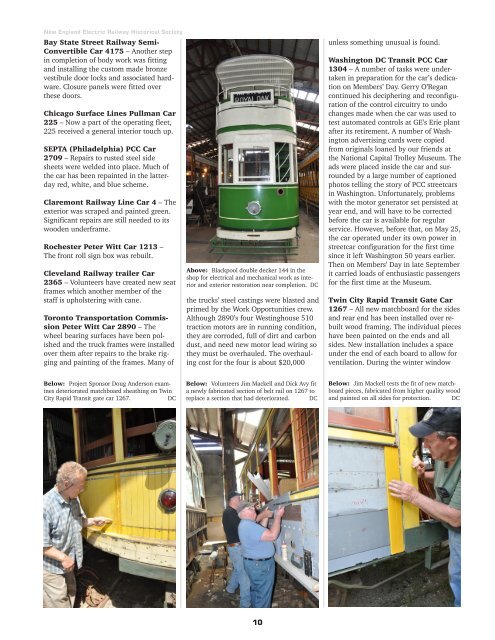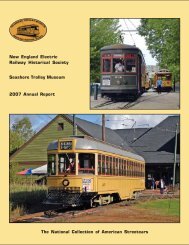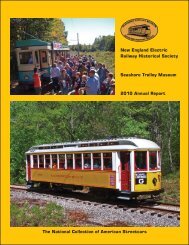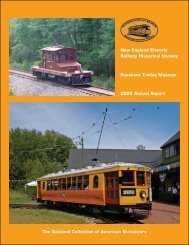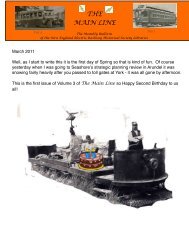2011 Annual Report - the Seashore Trolley Museum
2011 Annual Report - the Seashore Trolley Museum
2011 Annual Report - the Seashore Trolley Museum
Create successful ePaper yourself
Turn your PDF publications into a flip-book with our unique Google optimized e-Paper software.
New England Electric Railway Historical Society<br />
Bay State Street Railway Semi-<br />
Convertible Car 4175 – Ano<strong>the</strong>r step<br />
in completion of body work was fitting<br />
and installing <strong>the</strong> custom made bronze<br />
vestibule door locks and associated hardware.<br />
Closure panels were fitted over<br />
<strong>the</strong>se doors.<br />
Chicago Surface Lines Pullman Car<br />
225 – Now a part of <strong>the</strong> operating fleet,<br />
225 received a general interior touch up.<br />
SEPTA (Philadelphia) PCC Car<br />
2709 – Repairs to rusted steel side<br />
sheets were welded into place. Much of<br />
<strong>the</strong> car has been repainted in <strong>the</strong> latterday<br />
red, white, and blue scheme.<br />
Claremont Railway Line Car 4 – The<br />
exterior was scraped and painted green.<br />
Significant repairs are still needed to its<br />
wooden underframe.<br />
Rochester Peter Witt Car 1213 –<br />
The front roll sign box was rebuilt.<br />
Cleveland Railway trailer Car<br />
2365 – Volunteers have created new seat<br />
frames which ano<strong>the</strong>r member of <strong>the</strong><br />
staff is upholstering with cane.<br />
Toronto Transportation Commission<br />
Peter Witt Car 2890 – The<br />
wheel bearing surfaces have been polished<br />
and <strong>the</strong> truck frames were installed<br />
over <strong>the</strong>m after repairs to <strong>the</strong> brake rigging<br />
and painting of <strong>the</strong> frames. Many of<br />
Above: Blackpool double decker 144 in <strong>the</strong><br />
shop for electrical and mechanical work as interior<br />
and exterior restoration near completion. DC<br />
<strong>the</strong> trucks’ steel castings were blasted and<br />
primed by <strong>the</strong> Work Opportunities crew.<br />
Although 2890’s four Westinghouse 510<br />
traction motors are in running condition,<br />
<strong>the</strong>y are corroded, full of dirt and carbon<br />
dust, and need new motor lead wiring so<br />
<strong>the</strong>y must be overhauled. The overhauling<br />
cost for <strong>the</strong> four is about $20,000<br />
unless something unusual is found.<br />
Washington DC Transit PCC Car<br />
1304 – A number of tasks were undertaken<br />
in preparation for <strong>the</strong> car’s dedication<br />
on Members’ Day. Gerry O’Regan<br />
continued his deciphering and reconfiguration<br />
of <strong>the</strong> control circuitry to undo<br />
changes made when <strong>the</strong> car was used to<br />
test automated controls at GE’s Erie plant<br />
after its retirement. A number of Washington<br />
advertising cards were copied<br />
from originals loaned by our friends at<br />
<strong>the</strong> National Capital <strong>Trolley</strong> <strong>Museum</strong>. The<br />
ads were placed inside <strong>the</strong> car and surrounded<br />
by a large number of captioned<br />
photos telling <strong>the</strong> story of PCC streetcars<br />
in Washington. Unfortunately, problems<br />
with <strong>the</strong> motor generator set persisted at<br />
year end, and will have to be corrected<br />
before <strong>the</strong> car is available for regular<br />
service. However, before that, on May 25,<br />
<strong>the</strong> car operated under its own power in<br />
streetcar configuration for <strong>the</strong> first time<br />
since it left Washington 50 years earlier.<br />
Then on Members’ Day in late September<br />
it carried loads of enthusiastic passengers<br />
for <strong>the</strong> first time at <strong>the</strong> <strong>Museum</strong>.<br />
Twin City Rapid Transit Gate Car<br />
1267 – All new matchboard for <strong>the</strong> sides<br />
and rear end has been installed over rebuilt<br />
wood framing. The individual pieces<br />
have been painted on <strong>the</strong> ends and all<br />
sides. New installation includes a space<br />
under <strong>the</strong> end of each board to allow for<br />
ventilation. During <strong>the</strong> winter window<br />
Below: Project Sponsor Doug Anderson examines<br />
deteriorated matchboard sheathing on Twin<br />
City Rapid Transit gate car 1267.<br />
DC<br />
Below: Volunteers Jim Mackell and Dick Avy fit<br />
a newly fabricated section of belt rail on 1267 to<br />
replace a section that had deteriorated. DC<br />
Below: Jim Mackell tests <strong>the</strong> fit of new matchboard<br />
pieces, fabricated from higher quality wood<br />
and painted on all sides for protection. DC<br />
10


